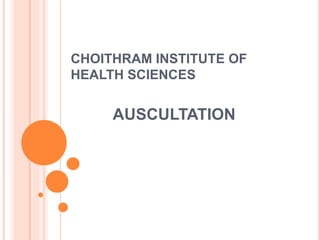
Auscultation
- 1. CHOITHRAM INSTITUTE OF HEALTH SCIENCES AUSCULTATION
- 2. Auscultation is a general term that refers to the process of listening to sounds within the body. Specifically to breath sounds during an examination of lungs. Auscultation of the chest must be done to note the type of breathing and presence of any foreign sounds.
- 3. AUSCULTATION OF BREATH SOUNDS- Procedure- when assessing breath sounds, be sure the setting is quiet. Have the patient assume a comfortable, relaxed position. Place the diaphragm of the stethoscope directly against the patients skin along the anterior and posterior chest wall. Follow a systematic pattern and place the stethoscope against thoracic landmarks ( T2, T6 and T10) along the right & left sides of the chest wall.
- 8. BREATH SOUNDS- Breath sounds are created by turbulent air flow. In inspiration, air moves into progressively smaller airways with the alveoli as its final location. As air hits the walls of these airways, turbulence is created and produces sound. In expiration, air is moving in the opposite direction towards progressively larger airways. Less turbulence is created, thus normal expiratory breath sounds are quieter than inspiratory breath sounds.
- 9. 1-VESICULAR- The vesicular breath sound is the major normal breath sound and is heard over most of the lungs. They sound soft and low-pitched. (rustling sound). This is characterized by active inspiration due to the passage of the air into the bronchi & alveoli followed without a pause by passive expiration due to the elastic recoil of the alveoli. 1 2 3 1-tubular phase 2-alveolar phase on inspiration 3-on expiration
- 10. BRONCHIAL- Loud, tubular high pitched sounds heard over the mainstem bronchi & trachea. This is characterized by active inspiration due to the passage of the air into the bronchi. The alveolar phase is absent (because of consolidation in alveoli) & hence expiration is also active. 1 3
- 11. If these sounds are heard anywhere other than over the manubrium, it is usually an indication that an area of consolidation. Bronchial sounds are heard equally during inspiration & expiration; a slight pause in the sound occurs between inspiration & expiration.
- 12. BRONCHOVESICULAR- Softer than bronchial sounds. 1 2 3 Active inspiration due to passage of air into bronchi & alveoli giving vasicular type of inspiratory sound. However during expiration there is increase resistance in the airway due to spasm causing inspiration to be active & hence equal to or more than inspiration. There is no pause between inspiration & expiration. They are best heard in the 1st and 2nd ICS (anterior chest) and between the scapulae (posterior chest) .
- 14. ADVENTITIOUS BREATH SOUNDS- CRACKLES- (rale) -Crackles are discontinuous, nonmusical, brief sounds heard more commonly on inspiration. They can be classified as fine (high pitched, soft, ) or coarse (low pitched, louder, ). Crackles are heard primarily during inspiration as the result of secretion moving in the airways or in closed airways that are rapidly reopening.
- 15. Causes-asthma bronchiectasis chronic bronchitis consolidation interstitial lung disease pulmonary edema Types of crackles- 1. Early inspiratory 2. Mid inspiratory 3. Late inspiratory
- 17. WHEEZE- Wheezes are continuous, high pitched, hissing sounds heard normally on expiration but also sometimes on inspiration. They are produced when air flows through airways narrowed by secretions, foreign bodies, or obstructive lesions. Causes:- asthma chronic bronchitis COPD pulmonary edema
- 18. RHONCHI;- Rhonchi are low pitched, continous, musical sounds that are similar to wheezes. They usually imply obstruction of a larger airway by secretions. STRIDOR- Stridor is an inspiratory musical wheeze heard loudest over the trachea during inspiration. Stridor suggests an obstructed trachea or larynx and therefore constitutes a medical emergency that requires immediate attention
- 19. PLEURAL FRICTION RUB- Pleural rubs are creaking or brushing sounds produced when the pleural surfaces are inflammed or roughened and rub against each other. Sound generally at the end of inspiration & in beginning of expiration. Conditions: pleural effusion pneumothorax CAVERNOUS BREATH SOUNDS- deep hollow sounds like blowing over a bottle.
